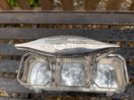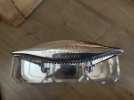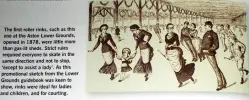In the early years of the 17th Century Sir Thomas Holte, a wealthy landowner, built a large stately home set atop of a sandstone ridge, two miles north of Birmingham Town. In the old dialect it was called Eastun (East Town, later Aston) Hall. It overlooked a shallow valley of open fields and woods complete with Old River Tame (as it's called on the 1888 map) meandering slowly northwards. In 1837 the Grand Junction Railway engineered a railway line loosely following the line of the river which lead from Birmingham to the North West. Witton railway station was thoughtfully provided next to the Hall. Sadly, at about this time, Aston Hall had deteriorated to the point that a windfall was needed to carry out substantial repairs. Finance for this was achieved by selling off a 31 acre parcel of land, (The Aston Lower Grounds) roughly triangular in shape, to a Bank. The land comprised the Hall’s vegetable and herb gardens, orchards and a large artificial fish pond.
The bank eventually leased the land to an entrepreneur, one H G Quilter. He was a bit of a visionary for his ideas were years ahead of their time. With this parcel of land he created perhaps the world’s first theme park, a hundred years before Disney, Alton Towers, etc. In 1875 he built a roller skating rink 300 feet long by 80 feet wide with a smooth asphalt floor. Alongside this, in 1879 he built a huge aquarium, 400 feet long and 60 to 80 feet wide with tanks containing fish, seals, octopus and other exotic species from around the world. The tanks required 300,000 gallons of water to be filled. On the first floor of this attraction an Art Gallery was provided. Many other attractions were built. At the southern shore of the pond a polar bear house was established and presumably appropriately populated. Around the grounds more attractions were built including a bandstand, tearooms, a rifle range, a bowling green and more menageries housing a wide range of exotic animals. At its peak the venue attracted over 280,000 visitors a year. Admittance to the grounds cost 3d and to the Aquarium 6d. The famous Victorian cricketer Dr W G Grace to play several test matches on the sports ground against an Australian eleven. FA cup semi finals were played here, and here the world’s first cycling record was set – some hero (Mr M Albin) rode around the track accruing 13 miles 600 yards in one hour on a penny farthing! Athletics also featured regularly on the red cindered track surrounding the sports field.
November 1887 witnessed arguably the pinnacle of the Lower Ground's events. Over 200 red Indians (mostly of the Sioux tribe), Mexicans, Cowboys and Rodeo Riders performed a series of Wild West shows lead by William “Buffalo Bill” Cody and Annie “Get your Gun” Oakley. Buffalo, prairie elk, horses and steer featured together with the real “Deadwood” stagecoach (shipped from the USA complete with bullet holes) performing circuits and rides around the racing track surrounding the sports field. Annie Oakley performed a sharpshooting routine and two Indians got arrested for drunkenness in one of the local pubs.
Following the death of Mr Quilter in 1893 fortunes changed. Railways made travelling cheaper and people were much attracted to sea-side venues which could provide similar attractions in a more exiting and exotic setting. Quilter’s death ensured that no one took up the challenges presented by the new century and its time was over.
In 1874 a new sports club had been founded by the Villa Cross Wesleyan Chapel Cricket Club in Birmingham whose members yearned for some sporting activity in the winter. The first sporting event played by the new club was a rugby match against Aston Brook St Mary's Rugby Club, followed the next week by a football match. It was decided that football was the way forward. The team prospered and took on the lease of grounds at Wellington Road, Perry Barr. The club's management instigated the football league and of course the renamed Aston Villa was a founding member. By the end of the century they had won three FA cup finals and 5 league finals. This success enabled the club to buy its own ground and as the site of Mr Quilters enterprise was available it was purchased outright in 1897, the year the club won both the FA Cup and the League.
For reasons not clear Aston Villa declined to use the existing sports ground and chose instead to set out their new pitch on top of the recently drained and filled lake where it has remained ever since. The old Aquarium Building was for may years Villa's offices, gym and snooker room until its demise in the 1980’s.
Next time I go to Villa Park I'll find myself staring intently at the Holte End goalmouth and perhaps see a ghostly polar bear staring with bemusement at a 40,000 attendance instead of his lake. Or a faint image of Buffalo Bill rounding up a Range Rover in the car park, behind which two Sioux Indians are lying, hopelessly drunk.
WP














